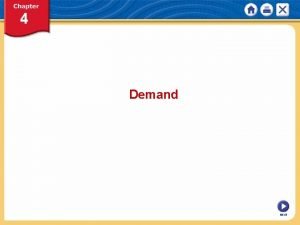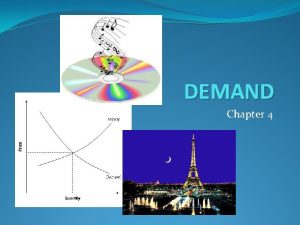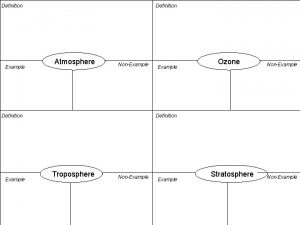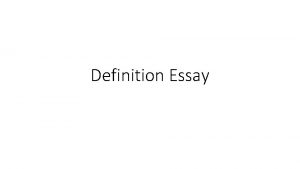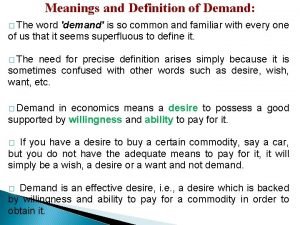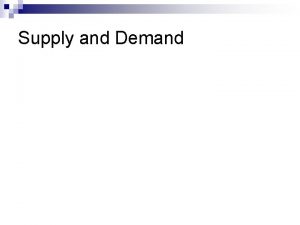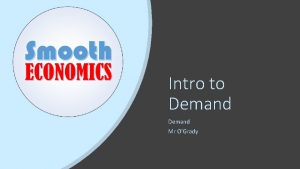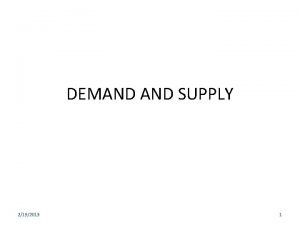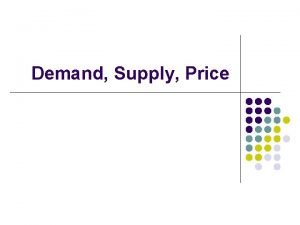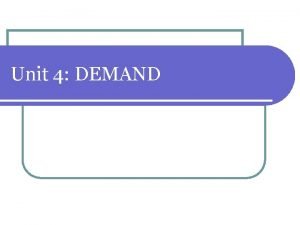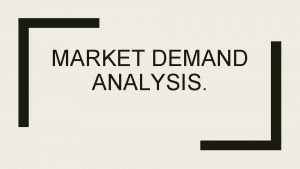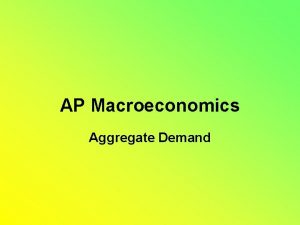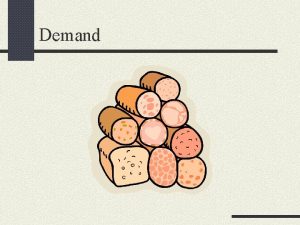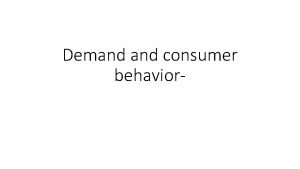Chapter 3 Demand The Definition of Demand Demand


































- Slides: 34

Chapter 3 Demand

The Definition of Demand �Demand is the quantities of a particular good or service consumers are willing and able to buy at different possible prices at a particular time.

The Definition of Demand �Demand “want” are not the same. �To economists, you demand things only when you are willing and able to buy them.

Demand the Price Effect �If the price of a hamburger at Mc. Donalds soared to $10, you would probably buy less. �In contrast, if the price dropped to 50 cents, you would probably buy more.

Demand the Price Effect �Price effect—People buy less of something at a higher price than they do at a lower price. �This is sometimes called the Law of Demand.

Drawing Demand Curves �Demand Price (of Gas) $6. 00 $5. 00 $4. 00 $3. 00 $2. 00 $1. 00 Schedule: Quantity Demanded 5 10 15 20 25 30

Drawing the Demand Curve �The Demand Curve is simply the demand schedule in graph form. �Price will always be on the vertical axis—quantity on the horizontal

How to Read the Demand Curve If price is $4, how much quantity is demanded? If price is $1, how much quantity is demanded?

Why do prices effect demand? �Buying Power �Diminishing Personal Value �Diminishing Marginal Utility �Substitutes

Buying Power �If the price of a product drops, your money can buy more of that product.

Diminishing Personal Value �As prices of a good rise, a person usually values the product for certain uses over others. �(ex, if price of gas goes up, you will buy only enough to go on your most important trips).

Diminishing Marginal Utility �The point reached when the next item consumed is less satisfying than the one before. �How many cookies can you eat before it’s just too much?

Substitutes �A good or service that can replace another good or service. �It may be less expensive and hold less appeal for a buyer. �(substitute for gas = walking) �Substitutes increase as price goes up

Market Demand �Market Demand is the sum of all individual demands in a given market at a particular time. �Suppliers of goods and services must look at the entire market’s demand when setting prices.

�Your friend owns a small business, and she wants to increase her revenue. However, she doesn’t know if she should increase or decrease the price of her goods to accomplish this. �What should she do? Discount or Markup?

IT DEPENDS!!! �Take these two examples… Southwest would decrease price National Fuel would increase price WHY the DIFFERENCE? ? !!!

Price Elasticity of Demand �Demand curves for all products slope downward from left to right, but their shape and steepness can be quite different. �The price effect is greater for some products than for others.

Price Elasticity of Demand �Elastic—When a small change in price causes a sharp change, or “stretch” in demand. �Inelastic—When the price effect is small, the demand is inelastic.

Activity �According to the graph on the board, which product is inelastic/elastic? �At which price is total revenue (TR) for both products the same? �TR = P x Q (what is the TR for both milk and cola at $1)? �If the price of cola increases from $1 to $1. 50, what happens to TR? Do the same for milk.

Elasticity of Demand �The elasticity of demand is different for different goods and services for the following reasons: ◦ Availability of Substitutes ◦ Percentage of Budget ◦ Time

Availability of Substitutes �When substitutes are more plentiful demand is more elastic. �Example—Cola has an elastic demand because there are many substitutes for it. (Juice, other sodas, etc)

Percentage of Budget �The bigger the percentage of people’s budget they spend on a product, the more elastic its demand tends to be.

Time �The longer people have to adjust to a price change, the more elastic demand tends to be.

The Price Effect Verses a Change in Demand �Market demand is the various quantities of a product people are willing and able to buy at different possible prices. �This means the demand for a product is not one quantity and one specific price. �It is all quantities at all different

The Price Effect vs. A Change in Demand �For demand to change, the entire curve must move.

What would make demand shift? �Brainstorm with your group, and come up with a list of what factors would make you buy more or less of something if the price of the good DID NOT change.

Causes of Change in Demand —take your responses and fit them under the following categories

�If Change in Income income rises, people are willing to pay higher prices for the same quantities—or buy greater quantities at the same prices.

Prices or the Availability of Substitutes �Demand of a product will change if the price or availability of a substitute changes.

Price or Availability of Complementary Goods �Goods that are used together are called complementary goods. �Example: If the peanut crop fails, the demand for jelly would drop.

Change in Weather or Season �Demand for goods can change according to season or weather. �Ex—sales of lemonade and loganberry increase during summer.

Change in the Number of Buyers �Population changes in an area effect demand. �More people—more demand.

Changes in Styles, Tastes, Habits �Changes in fashions and designs have an impact on demand.

Change in Expectations �If people suddenly decide a product will be more scarce and higher priced in the future, then the current demand for that product will change.
 Hình ảnh bộ gõ cơ thể búng tay
Hình ảnh bộ gõ cơ thể búng tay Frameset trong html5
Frameset trong html5 Bổ thể
Bổ thể Tỉ lệ cơ thể trẻ em
Tỉ lệ cơ thể trẻ em Gấu đi như thế nào
Gấu đi như thế nào Glasgow thang điểm
Glasgow thang điểm Alleluia hat len nguoi oi
Alleluia hat len nguoi oi Môn thể thao bắt đầu bằng từ chạy
Môn thể thao bắt đầu bằng từ chạy Thế nào là hệ số cao nhất
Thế nào là hệ số cao nhất Các châu lục và đại dương trên thế giới
Các châu lục và đại dương trên thế giới Cong thức tính động năng
Cong thức tính động năng Trời xanh đây là của chúng ta thể thơ
Trời xanh đây là của chúng ta thể thơ Mật thư anh em như thể tay chân
Mật thư anh em như thể tay chân Phép trừ bù
Phép trừ bù Phản ứng thế ankan
Phản ứng thế ankan Các châu lục và đại dương trên thế giới
Các châu lục và đại dương trên thế giới Thể thơ truyền thống
Thể thơ truyền thống Quá trình desamine hóa có thể tạo ra
Quá trình desamine hóa có thể tạo ra Một số thể thơ truyền thống
Một số thể thơ truyền thống Cái miệng bé xinh thế chỉ nói điều hay thôi
Cái miệng bé xinh thế chỉ nói điều hay thôi Vẽ hình chiếu vuông góc của vật thể sau
Vẽ hình chiếu vuông góc của vật thể sau Biện pháp chống mỏi cơ
Biện pháp chống mỏi cơ đặc điểm cơ thể của người tối cổ
đặc điểm cơ thể của người tối cổ V cc cc
V cc cc Vẽ hình chiếu đứng bằng cạnh của vật thể
Vẽ hình chiếu đứng bằng cạnh của vật thể Phối cảnh
Phối cảnh Thẻ vin
Thẻ vin đại từ thay thế
đại từ thay thế điện thế nghỉ
điện thế nghỉ Tư thế ngồi viết
Tư thế ngồi viết Diễn thế sinh thái là
Diễn thế sinh thái là Các loại đột biến cấu trúc nhiễm sắc thể
Các loại đột biến cấu trúc nhiễm sắc thể Các số nguyên tố
Các số nguyên tố Tư thế ngồi viết
Tư thế ngồi viết Lời thề hippocrates
Lời thề hippocrates




































